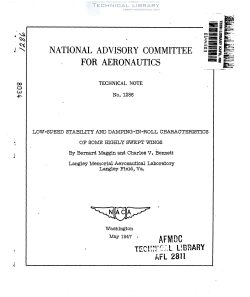naca-tn-1286
- Version
- 145 Downloads
- 763.75 KB File Size
- 1 File Count
- December 4, 2016 Create Date
- December 4, 2016 Last Updated
National Advisory Committee for Aeronautics, Technical Notes - Low Speed Stability and Damping in Roll Characteristics of Some Highly Swept Wings

Tests have been conducted to determine the low-speed stability,
damping-in-roll, and stall characteristics of five wings, three
wings with 1L2° sWeepbacko and having aspect ratios of 5' .9, 3, and
2, and two wings with 33° sweepforward and having aspect ratios
of 5.9 and 3 The results showed that the wings of aspect ratio
5.9 were longitudinally unstable at the stall but that reducing
the aspect ratio tended to eliminate the instability. SweepfOrward
produced a maximm value of negative effective dihedral approxi-
mately one-half of the positive value produced by sweepback. Over
the linear range of the lift curve the swept-forward wings had zero
directional stability, whereas the swept-back wings had a marked
increase in directional stability with lift coefficient. The
damping in roll was reduced with reduction in aspect ratio over
the linear range of the lift curve. Above the linear range of the
lift curve the damping in roll'decreased with increasing lift
coefficient for the swept-back wings and increased with increasing
lift coefficient for the swept-forward wings. Autorotation at the
stall was obtained only with the swept-back wing having an aspect
ratio of 2.
An investigation to determine the low-speed stability and
control characteristics of highly swept wing planforms is being _
conducted in the Langley free-flight tunnel and in the Langley
15-foot free -spinning tunnel. Some results of damping-in-roll
tests, force tests, free-flight tests, and tuft tests of these
wings are presented in references 1 and 2. In the present paper,
results are given of experimental investigations conducted to
determine the low-speed stability, damping-in-roll, and stall
characteristics of five wings, three wings with M20 sweep‘back and
having aspect ratios of 5 9, 3, and 2 , and We wings with 38° sweep-
forward and having aspect ratios of 5 .9 and 3.
| File | Action |
|---|---|
| naca-tn-1286 Low Speed Stability and Damping in Roll Characteristics of Some Highly Swept Wings.pdf | Download |

Comment On This Post